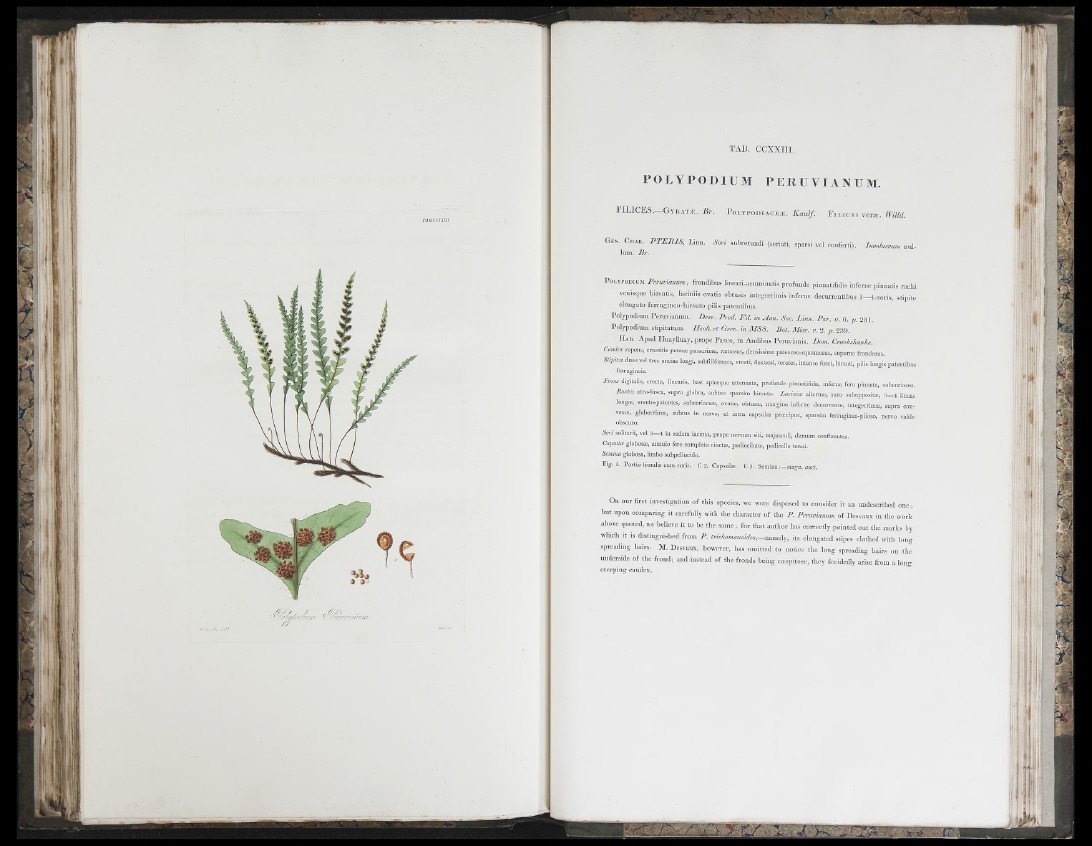
P O L Y P O D I U M P E R U V I A N U M .
F IL IC E S .—G y e a t æ . B r . E o l y p o d i a c e æ . K a u lf . F i l i c e s v e ræ . Willd.
Gen. C h a r . P T E R I S , Lmn. S o ri subrotundi (serinti, sparsi vel c o n fe ti), h a o ltm -um nui-
lum. B r .
P o ly p o d ium P e ru v ia n um ; frondibus lineari-aciiraiuatis profunde pinnatifidis mferue pinnatis rachi
vcnistpie hirsutis, laciniis oyatis obtusis integerrimis iafcmc decurrentibus 1—4-soris, stipite
elongato fcrrugineo-hirsuto pilis patentibus.
P olypodium Peruvianum. D e s v . P ro d . P i t . in A n n . See. L in n . P u r . v . 6 . p . 231.
Polypodmm stipitatum. H o o k e t G re v. in M S S . B o t. M is c . v. 2 . ;i. 2 3 9 .
Hab . Apud Huaylluay, propc P a sco , in Andibus Peruvianis. D om . Cruekshanks.
Carni,s repens. crassitie pennæ p.asserinæ, ramosas, densissime paleaceo-squamosus, superne frondosus.
S liiA te , duas vel tie s uncias longi, subffliformes, erecti, fle.vuosi, teretes, intense fusci, hirsuti, pilis longis patentibus
ferrugineis.
F ro n s digitalis, erecta, linearis, basi apiceque attenuata, profunde pinnatifida, inferne fere pinnata, siibcoriacea.
B u c h is atro-fusca, supra glabra, subtus sparsim hirsuta. L a c in ic c alternæ, raro suboppositoe, 3— 4 lineas
lon gæ, e recto-patentes, subeoriaceæ, ovatæ, obtusæ, margine inferne decurrente, integerrimæ, supra con-
v exoe, g labernmæ, subtus in nervo, et intra capsulas præcipue, sparsim ferrugineo-piloso, nervo valde
obscuro.
Sa ri solitarii, vel 3— 4 in eadem lacinia, prope nervum siti, majusculi, demum confluentes.
Capsulæ globosæ, annulo fere completo cinctæ, pedicellatoe, pedicello tenui.
S emin a globosa, limbo subpeUucido.
F ig . 1. Po rtio frondis cum soris. f . 2 . Capsuloe. f. 3. Semina a,M.
On our first m v e slig a tio ii o f this species, we were disposed to consider it an undescribcd o n e ;
but upon comparing it carefully w ith the character o f the P . P e ru v ian um o f De svaux In the work
above qnoted, we believe it to be the sam e ; for that author has correctly pointed ou t th e marks hy
which It IS distingnishcd from P . trickomanokks,— u om A y , its e longated stipes clothed with long
spreading hairs. M. Desvaux, however, has omitted to n otic e th e lo n g spreading hairs on the
underside o f the frond; and instead o f the fronds b e in g ciespitose, th ey decidedly arise from a
t lon g
creeping ciuidcx.
; t lli
; l ‘
À
1 \'H- \ ■ f v j
' ; : M i T -1
j * • 1
i iff- ?
ri' "
f t e
«
Î A. ' ' J
i t e t e te:?